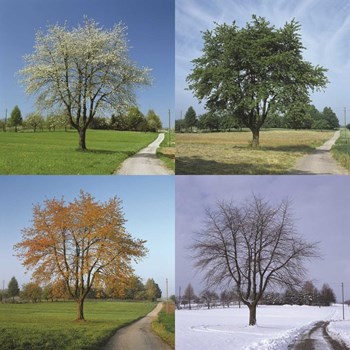
With freshly-fallen snow blanketing your condominium landscape, it’s easy to be lulled into thinking the property really is “pretty as a picture.” But keep in mind that in a few short weeks, that blanket may be melted away, revealing an array of blemishes that might have been ignored in the fall, or damage created by winter’s icy blasts.
This quiet period when board members are tucked comfortably indoors offers an opportunity to contemplate the balmier seasons to come — and to review the association’s checklist of tasks that should be completed before residents want to enjoy the community grounds.
“New England is different every year,” says Bart Poulin, whose Greener Horizon landscape management firm services Massachusetts communities from the Cape to Worcester, and into Rhode Island. “And within Massachusetts alone, there are two landscape zones,” each with its own timetable and plant hardiness.
“Ideally,” he says, “associations will find a contractor for the spring season in the fall, when they’re doing their budgets — in September or October. We like to have contracts signed by February 1.” Associations that delay planning for spring may find contractors booked up, and unavailable when they’re most needed.
It’s a Year-Round Effort
“Each property has specific needs,” notes Stephen DiNocco, principal of Affinity Realty & Property Management in Boston, “and the severity of the weather and the extent of the winter all have an impact on what is done and when. You have to be observant and adaptable. The reality of it is that inspections are ongoing throughout the year and most of the maintenance is preplanned with the provider.”
So what tasks should be on the association’s agenda when winter finally loosens its grasp? The list can be lengthy, extended from the parking lot, across the front lawn and into the lobby, experts suggest.
“In early spring, soon after the final snow, we make an assessment of the property, examining the roofs, siding, carpeting, fencing and landscape. Work is scheduled to address any defects caused by the weather. Carpets and floors are cleaned,” DiNocco says. And hard as it may be to think about when piles of snow still ring the parking lot and icy winds are blowing, it will soon be time to think about air conditioning. Spring will soon be here, and with it, time for “HVAC to be prepared for summer and heating systems decommissioned,” he says.
In the meantime, the remnants of winter need to be removed, not only to improve appearances, but also to protect the property from further damage. Dirt tracked from parking lots and sidewalks can create havoc with carpets and flooring, causing unnecessary wear and forcing premature replacements.
“All the common areas need to be cleaned,” suggests Leonard Fondini, owner of The Leonard Company in Peabody, Massachusetts, which provides a wide variety of cleaning services for commercial and residential properties. “Windows can be cleaned, carpets shampooed — and you want to look for any safety issues that might have arisen during the winter,” Fondini adds. One problem he sees at condominiums when spring arrives is damage caused by salt that’s been used as an ice-melt during the winter. “I don’t use salt,” when maintaining properties in winter, he says. “I use a green, environmentally-sound pellet product with a spreader. It dissipates on the parking lot, it’s pet-friendly and it’s safe.” Any additional cost for the new, more environmental product, he suggests, can be weighed against the cost of repairing or replacing salt-damaged concrete and landscaping, and the maintenance involved in cleaning up the salt debris.
“Parking lots should be swept, and you want to look for any maintenance issues with fences. It’s a good time to check lighting, because that’s a safety and insurance issue.”
While budgets are always a concern, Fondini notes, as light bulbs are changed, it’s a good idea to look at newer technologies. “Lately, we’ve been changing to LED bulbs because they’re so much more efficient. They’re brighter, and they have a long life expectancy,” he says. “The bulbs are expensive, and you have to get past the sticker shock — but they are the wave of the future.” The increased cost of the new bulbs has to be viewed in terms of savings on both electric bills and the maintenance costs of constantly replacing burned-out incandescents.
Speaking of Green …
There’s nothing that says “spring” like that first blush of green lawn and splash of color in flower beds. But, as any New Englander knows, early spring can not only be drab, but the melting snow can reveal a winter-damaged landscape replete with broken branches, autumn leaves that somehow escaped fall cleanup or arrived unwelcome on early winter winds, snow mold on lawns and more.
A spring tour of the property with the landscape contractor is in order. It’s time to make a list of damaged trees and shrubs, disturbed flower beds, and loose bricks or cobblestones on walkways.
“Hardscape projects can start as soon as the ground is thawed. It doesn’t matter what the temperatures are at night, as long as the ground isn’t frozen.” Poulin says. “And if you want to do them in the spring, you really should have been talking about them at the beginning of winter. In the spring, a lot of contractors will be getting booked up, so you want to plan early” for those patio, sidewalk and other construction jobs. “Once the snow is gone, projects get rolling,” he says. “Some years, we’ve started in March; last year, we couldn’t get started until April” due to weather conditions. Projects that may have gotten off the ground too late for spring construction could be scheduled for late summer, when landscape contractors slow down a bit or even early winter, depending on the weather, he notes. Of course, that delay means the association has missed the opportunity to enjoy the project this summer — but, as Red Sox fans were long known to say, there’s always next year.
But even without any major projects in mind, associations should be taking a good look at the property in early spring. “You want to prune out dead branches, things that were damaged by snow load. Inspect plants like arborvitae that may be bent and need to be tied back up or pruned due to damage,” he advises. “Pruning is important; you want to prune off the dead branches so that the plant is less susceptible to disease,” he stresses.
Ideally, Poulin says, associations have lined up their landscape contractors in the fall while working on the next year’s budget, so that everyone is ready to go when winter fades away. The early spring walk-around can be done by the contractor, accompanied by the manager and perhaps the landscape committee chair, so that everyone sees and understands any problem areas that need to be addressed. “The walk-around can help you come up with a game plan” for the season ahead, he notes.
Disappearing snow gives landscapers an opportunity to see how well lawns survived the winter, and how healthy they’ll be as warm weather arrives. “If you do one aeration and over-seed a year, I recommend doing it in the fall; if you do it twice a year, then the other time is in the spring, as soon as the snow is gone.” Local turf problems that might be spotted in the spring include red thread, a fungus that attacks grass, and snow mold.
Badly damaged trees will require expert attention to avoid further damage to the trees, the property — and workers. Large branches that have broken off during the winter should be cut up and hauled away. Any dead or damaged branches still on the tree should be properly trimmed to protect its health. After a really difficult winter, especially one replete with ice storms like Maine experienced this season, there may be trees that are just too badly damaged to save. A tree expert will be able to assess the damage and suggest what can be saved and what will have to be removed and replaced.
A common problem found at New England condominium properties is overgrown plantings. With budgets tight, especially in recent years, preventive maintenance in the landscape arena is often one of the first items to be trimmed. Trees that were planted close to buildings can become not only a nuisance, but a danger to the property; overgrown trees and shrubs can block the vistas that attracted buyers in the first place. “A lot of condos were built 20 or 30 years ago, and the shrubs have really grown. They really reach their peak at 30 years, and become large and difficult to prune. At that point, they may need to be removed or renovated. Some condos will do that work in phases,” Poulin says.
With chill winds still blowing, it may be hard to believe that spring is on its way. But under the mantle of white lies a landscape just waiting for attention. Wise associations will be ready to act when, seemingly without warning, the New England winter turns into spring.
Pat Gale is associate editor of New England Condominium.






Leave a Comment